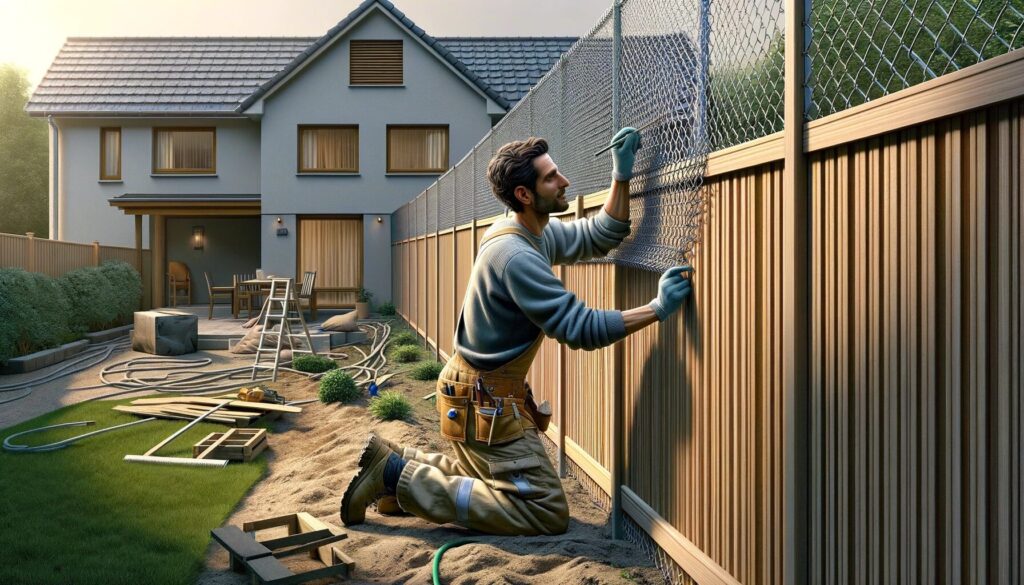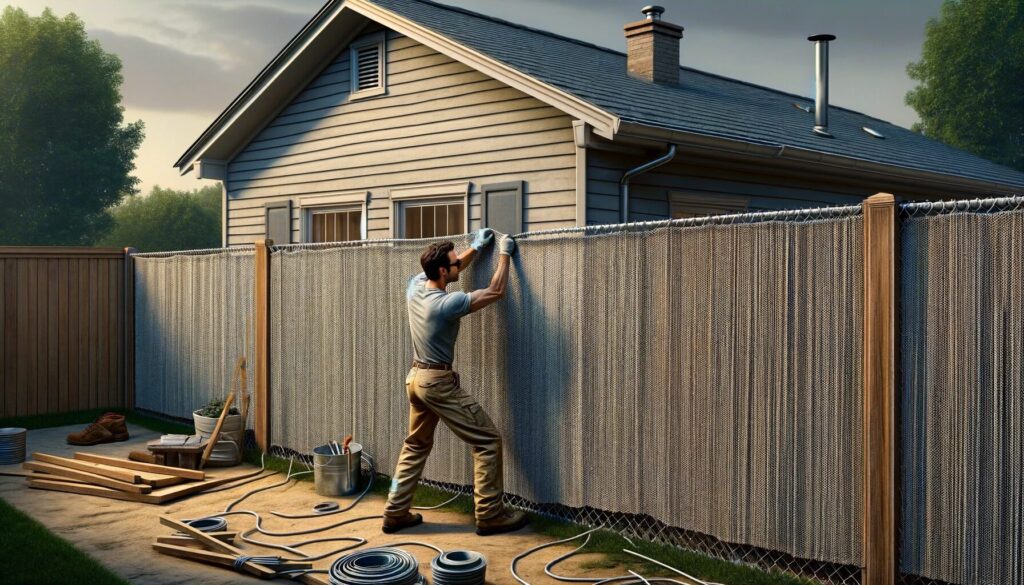Chain link fences are a staple in many American yards. They’re the workhorses of the fencing world: affordable, sturdy, and low-maintenance. However, they’re not known for their privacy or aesthetic appeal. This is where a bit of creativity and practical know-how can transform these utilitarian structures into something both functional and visually pleasing.

Understanding Chain Link Fences
These fences are made of steel wires woven into a diamond pattern, usually coated with zinc to prevent rusting. Known for their durability, they withstand weather elements and don’t face issues like rot or pest infestation, common in wooden fences. However, their open weave design leaves little to the imagination, prompting many homeowners to seek ways to enhance their privacy and visual appeal.
Options for Covering a Chain Link Fence
Using Plants for Coverage
- Vines: Ideal for creating a green facade, fast-growing vines like Ivy or Clematis can effectively weave through and cover the fence. However, be cautious with invasive species, which can overgrow and become hard to manage.
- Shrubs: For a more structured approach, shrubs like Boxwood or Privet, planted along the fence line, can provide a dense barrier. Regular trimming is essential to maintain their shape and prevent overgrowth.
Synthetic Privacy Screens
- Polyethylene Screens: These are practical solutions for quick coverage. Available in rolls, they can be attached directly to the fence with zip ties. They offer immediate privacy but may not withstand harsh weather over time.
- Woven Screens: These are a step above in terms of durability and style. Attached similarly with ties or wires, they offer a more enduring solution to fence privacy.
Wooden Slats or Panels
- Individual Slats: Weaving wooden slats through the chain link fence blends the natural look of wood with the fence’s durability. It’s labor-intensive but offers a unique, hybrid aesthetic.
- Full Panels: This method involves attaching entire wooden panels to the fence, essentially creating a new fence in front of the old one. It’s a significant transformation, providing a complete privacy solution but requires more investment in terms of cost and labor.
Covering a chain link fence can be an effective way to enhance privacy and add a personal touch to your outdoor space. Whether you choose the natural route with plants, the quick fix of synthetic screens, or the sturdiness of wooden panels, each option offers its unique blend of aesthetics and functionality. Remember, good results come from careful planning and execution, so take your time to choose the right solution that fits your needs and complements your home.

Step-by-Step Installation Guide
Preparing Your Chain Link Fence for Coverage
- Inspect the Fence Thoroughly: Start by examining every inch of your chain link fence. Look out for any signs of wear like rust or damaged links. Tighten any bolts that have loosened over time and ensure the posts are firm in the ground.
- Clean the Fence: A clean fence ensures better adherence for any coverings. Use a garden hose or a pressure washer to remove dirt and debris. Let the fence dry completely before proceeding.
Detailed Steps for Each Covering Option
- For Plants:
- Selecting Suitable Plants: Choose climbers or shrubs that thrive in your local climate and can handle the fence’s exposure to sunlight.
- Planting: Dig planting holes a reasonable distance from the fence, following the spacing suggested for your chosen plant species.
- Guiding and Training the Plants: Gently guide the young vines through the fence’s links. Use soft garden ties to secure them if necessary.
- For Synthetic Privacy Screens:
- Accurate Measurement: Measure your fence precisely to determine the size of the screen you need.
- Attaching the Screen: Fasten the screen onto the fence with zip ties or wire, ensuring it’s stretched tight to prevent it from sagging or flapping in the wind.
- For Wooden Slats or Panels:
- Preparing the Wood: Measure and cut your wooden slats or panels according to the dimensions of your fence.
- Installation: For slats, weave them through the links of the fence. For panels, secure them directly to the fence posts using screws.
Safety Tips and Tools Required
- Personal Protective Equipment: Always wear gloves, safety goggles, and sturdy boots to protect yourself.
- Required Tools: The tools you’ll need will vary. For planting, basic gardening tools will suffice. For wooden installations, prepare to use saws, drills, and hammers.
Pros and Cons of Each Covering Method
Plants
- Pros:
- Adds a natural and aesthetic touch to the landscape.
- Can be an economical option in the long run.
- Beneficial for the environment and local biodiversity.
- Cons:
- Takes time to grow and achieve full coverage.
- Regular maintenance like watering and pruning is necessary.
- Potential for attracting garden pests.
Synthetic Privacy Screens
- Pros:
- Quick and easy installation for immediate privacy.
- Available in various designs to match different aesthetics.
- Low maintenance.
- Cons:
- Can deteriorate over time, especially in harsh weather conditions.
- May not integrate well with natural garden elements.
Wooden Slats or Panels
- Pros:
- Robust and long-lasting.
- Provides a high degree of privacy.
- Wood’s natural look can enhance the yard’s overall appearance.
- Cons:
- Higher initial cost compared to other options.
- Installation can be labor-intensive.
- Regular maintenance is required to prevent issues like rot and insect damage.
Customization and Creative Ideas
Customizing your chain link fence is more than a weekend project, it’s a chance to infuse personality into your property. Let’s explore how you can make that metal mesh sing.
- Color Choices: When selecting colors for synthetic screens or wooden slats, consider the palette of your home’s exterior. Use wood stains or waterproof paints that both protect and enhance the natural grain. For synthetic screens, choose hues that blend or contrast pleasingly with your garden.
- Material Combinations: Combining materials can offer both aesthetic appeal and functional benefits. Consider intertwining wooden slats with climbing plants for a mix of organic and structured elements. Alternatively, create a pattern with different types of synthetic screens for a unique look.
- Artistic Flair: Your fence can be a canvas. Painting mural designs on wooden panels or attaching custom art pieces can transform a mundane fence into a focal point of your yard.
- Lighting: Integrating lighting, such as solar-powered LEDs, along the fence not only enhances security but also adds a charming ambiance to your evenings outdoors.
Maintenance and Upkeep
Different coverings require different care strategies:
- Plants: Regular pruning and watering are essential. Monitor for pests and diseases, and ensure climbers don’t overburden the fence structure.
- Synthetic Screens: These need minimal upkeep. Periodically check for and repair any damage, particularly after inclement weather.
- Wooden Slats or Panels: Wood demands more attention. Regular applications of stain or paint are necessary to ward off weathering and rot. Keep an eye out for insect damage and address it promptly.
FAQ Section
The key is in the coverage density. For plants, opt for species that grow densely. In synthetic screens or wooden options, choose designs that offer little to no visibility.
While plants may require time to mature, they are generally the most cost-effective in the long term. Synthetic screens offer a budget-friendly and immediate solution.
Always be mindful of local ordinances and homeowner association regulations. These can influence fence height and style restrictions.
Choose materials that harmonize with your garden’s aesthetic. Natural materials like wood, or greenery, blend seamlessly into outdoor spaces.
Many fence covering options are well within the reach of a skilled DIY enthusiast. However, for more complex installations, especially involving woodwork, professional assistance may be beneficial.
